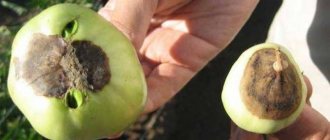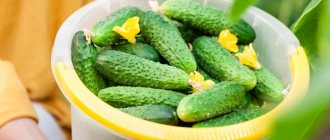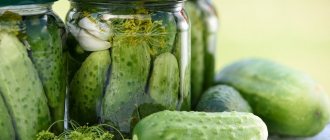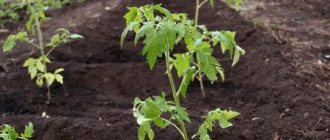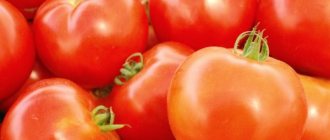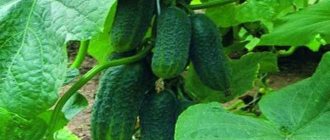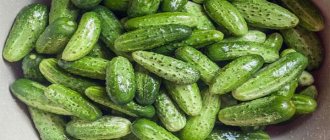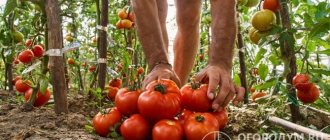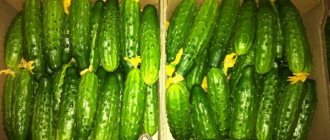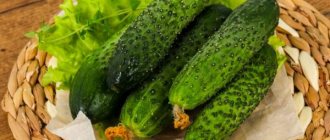Planting and growing
Cucumbers are sown in open ground 1–2 weeks after the last spring frost.
The second batch of seeds can be sown a month after the first. In regions with cool summers, planting begins with growing seedlings 3 weeks before planting in the ground. At a temperature of +20°C and a humidity of 60–70%, cucumbers will germinate in 3–5 days. For planting in the ground, choose a sunny area with fertile and well-drained soil with a pH of 6.0 to 6.5. Plants are planted on hills located at a distance of 1.5–2 m from each other.
Cucumber planting scheme.
For planting you will need:
- remove all stones, sticks or other debris from the area;
- dig up the area;
- mix the soil with a bucket of humus or other organic fertilizers;
- water the soil before planting seeds or seedlings.
Growing cucumbers in a greenhouse is quite simple - they will need frequent watering. Seeds are sown from April to May. The soil is dug up and disinfected by treating with boiling water and a solution of copper sulfate 7%. Be sure to apply organic fertilizers.
Important! Seeds are always stored at room temperature and for no more than 2 years. In other situations they begin to lose viability
Plants will need a vertical or horizontal trellis to form the bush. When the seedlings reach the maximum height of the trellis, pinch the apical bud to begin branching the vine: in this way you can slightly increase the yield of the vines.
Forming a cucumber.
Grandson F1 is a hybrid variety of cucumbers. Basic characteristics of the crop, cultivation, pros and cons
A small cucumber is always popular. But Grandson F1 gained fame not only due to its parameters. It also produces a good harvest. The article will help you understand the questions that novice gardeners have: how to recognize a variety by description, where it is best to grow, what to consider during the cultivation process, how gardeners respond to the crop.
Description of the hybrid
Cucumber Granddaughter F1 is a hybrid that does not require insects for fruiting. Unprotected beds, greenhouses of various types and greenhouses are suitable for growing crops. The variety is characterized by early and long-term fruiting.
Cucumber is indeterminate, branching and height are moderate. The foliage is also sparse. The ovary is formed as a bunch, all flowers are productive.
Attention! Cucumber Vnuchok F1 is supplied to the Russian market by Aelita. Currently, the company has exclusive rights to sell this seed material
The fruits have the shape of an elongated oval. The cucumber is green, but the peel is slightly lighter at the base. The photo shows that the vegetable has yellow stripes. They reach 1/3 of the fruit. The skin with small tubercles and pronounced pubescence. The cucumber is juicy, without bitterness.
| By type of growth | Medium-climbing |
| By type of branching | Medium branched |
| By type of pollination | Parthenocarpic |
| Planting scheme | 60x15 cm |
| Weight, length and shape of the fruit | 63 – 76 g, 7.5 – 9 cm, oval cylinder, green with light stripes |
| Ripening period | Early ripening (38 – 42 days) |
| Usage | Universal |
| Drop off point | Exhaust gas/greenhouse/greenhouse/on balconies and loggias |
| Diseases | Resistance to cucumber mosaic, root rot, olive spot, powdery mildew. Tolerance to downy mildew. |
| Flowering type | Female |
| Productivity | In the greenhouse 33 kg/m2; in exhaust gas - 19 kg/m2 |
Advantages and minor disadvantages
Among the advantages of cucumber are:
- Juiciness, excellent taste characteristics, no bitter aftertaste.
- Long period of fruit production.
- Good transportability over long distances.
- Strong immune protection against diseases to which non-hybrid cucumbers are susceptible.
- Short period between planting seeds and fruiting.
- Productivity that increases when planted in a greenhouse.
- Wide range of ways to use.
The disadvantages include:
- the lack of seed material characteristic of all hybrids;
- If the harvest is untimely, the skin of the fruit becomes too hard.
Features of agricultural technology of this plant
Direct planting of seeds in the ground and seedling type of cultivation are acceptable for the crop. Growing principles:
- seed material is immersed in the soil by 1 - 2 cm;
- when sowing directly into the ground, it is necessary for the air to warm up to 15 degrees, and the soil to 13 degrees;
- cucumber is planted in 3 - 4 bushes per 1 m²;
- the stem of the crop is attached to the trellis;
- the first 5 ovaries and 2 shoots are removed, then pinching is carried out on the stepsons after the appearance of the 2nd leaf.
Advice. If the garden plot is small, cucumber can be grown on the balcony. To do this, you need to tighten the supports for the branches and prepare a large container with soil.
| End of April – 1st decade of May | After the end of frost | the end of May | Removal of 1st and 2nd processes | End of June, July |
| *dates are indicated for central Russia |
In reviews, gardeners describe the appearance of the cucumber, the number of fruits produced, and the secrets of planting the crop:
- A gardener from Krasnoyarsk wrote a unique instruction on growing vegetables on a balcony. She claims that the Vnuchok F1 cucumber also bears fruit there.
- Muscovite Elena is pleased with its yield, sweetish taste, and crispy pulp.
- Maria from Nizhny Novgorod noted that the fertility of the crop in a greenhouse is much higher than in an open garden bed.
- An anonymous gardener notes that the plant can withstand hot weather.
Grandson F1 is a cucumber worthy of the attention of every gardener. This variety can please you with its harvest, taste, and immunity. It can be grown even on a small plot of land.
Description of cucumbers of the Babushkin Secret f1 variety, cultivation and care
One of the new products in the gardens of our compatriots is the cucumber Grandma's secret f1. It appeals primarily to greenhouse owners. In addition, cucumbers of this variety can be grown on the balcony or windowsill of your home. Northern climate conditions suit it. But you need to know certain features inherent in these cucumbers.
Description of the variety
Cucumbers of the Babushkin Secret variety are early parthenocarpic hybrids. Already 50 days after germination, you can enjoy the first harvest. Reviews from summer residents indicate that under ideal conditions, the fruits began to ripen within 40 days. For lovers of early harvests, this is a real find. The bush of Grandmother's Secret is medium in size; long-term fruiting is ensured by indeterminateness.
Cucumbers are a type of bunch varieties. This means that they bloom in bouquets, and several fruits are formed in the axils. The fruits reach sizes of 10–12 centimeters, and the weight of each of them is 90–100 grams. For canning, the crop is harvested at the pickle stage. The size of cucumbers at this time is only 4–5 centimeters.
Cucumber Grandma's secret f1 is intended for cultivation in open ground. Only due to the fact that they do not require the participation of insects for pollination, the variety has gained great popularity among greenhouse owners. It should be noted that in the latter case, these cucumbers became indispensable.
Main advantages and disadvantages
The Babushkin Secret variety has significantly more advantages than disadvantages. That is why most gardeners already grow it on their plots. The positive qualities of cucumbers include:
- high yield (in greenhouses the figures reach 15–16 kg, and in open ground - 6–8 kg);
- has no barren flowers;
- excellent taste;
- universal application;
- increased resistance to diseases;
- suitability for long-distance transportation.
But Grandmother's Secret also has certain disadvantages. If flower stalks are pollinated by bees and deformation of the fruit occurs, then unwanted cucumber bitterness may appear. Also, gardeners will not be able to independently collect seeds and prepare seed material for the next season. Even if female peduncles pollinated by bees produce fruits with seeds, it will not be possible to obtain plants with the same characteristics as the mother plant. This is the disadvantage of all hybrid varieties.
Features of cultivation
Cucumbers of the Babushkin Secret variety are undemanding in care and growing conditions. However, the soil must be selected with a high content of turf and humus. You should not plant plants in the same bed where cucumbers were already grown last season. For good development of bushes, it is required that the air temperature does not drop below +15 ⁰C.
You can grow Grandma's Secret either by seedlings or by direct sowing in the ground. The seeds have good germination. The sowing depth is 1.5–2 centimeters. The soil should be loose, well permeable to air and moisture. It is advisable to prepare seedlings for growing in greenhouses. It is planted in a permanent place of growth when 4 true leaves are formed.
Features of care
Grandma's Secret cucumbers need regular watering. For this purpose, it is good to resort to the use of drip irrigation systems. Their advantage is that moisture goes directly to the roots and does not harm the leaves. The threat of water stagnation is also eliminated, which is important with the greenhouse growing method.
To prevent diseases and improve air circulation, the beds where Grandma's Secret cucumbers grow are regularly weeded and weeded. To obtain high yields, plants require timely staking and pinching of side shoots. This variety is grown mainly by trellis method.
When tying the stems, you need to pay attention so that the twine does not overtighten the stem. Otherwise the plant may die
Timely harvesting of Grandmother's secret provokes the formation of new ovaries. This hybrid can form from 2 to 6 of them in each sinus. The variety is characterized by rapid fruit production and very early ripening. This advantage is used by gardeners in those regions that have short summers.
Grandmother's secret is in great demand, which is why cases of sales of counterfeit seeds of this variety have become more frequent. If you plan to grow a high-quality crop with the expected characteristics, then you should purchase planting material in branded stores that have a good reputation.
Features of agricultural technology of the variety
The high yield of this variety of cucumbers depends on compliance with the rules of agricultural technology. Grow in two ways:
- seedling;
- direct sowing of seeds into the soil.
The seedling method is used by gardeners living in regions with cool climates. Vegetable growers grow seedlings to get the harvest earlier.
Important!
The soil should be nutritious and light: a mixture of peat, sand and garden soil is best.
Young plants are transferred to unprotected soil at the end of May. The recommended planting pattern is 50x50cm.
You may be interested in:
- Formation. The shoots are removed, the flowers remain in the axils, the stems and flowers are removed only from the first 5 leaves.
- Hilling. One of the types of soil cultivation. Sprinkling moist, finely lumpy soil onto the roots and base of the stem while simultaneously loosening it.
- Weeding. Removing weeds.
- Watering. To prevent fungal infection, water the soil with warm water every 2-3 days under the plant in the evening. In hot weather, water the plant twice a day - morning and evening.
- Feeding. They use organic matter and minerals - K preparations (potassium), simple mineral phosphorus fertilizer (P), ammonium nitrate mineral fertilizer (NH₄NO₃).
- Foliar irrigation (feeding). This is the application of fertilizers, in which plants receive nutrients through stems and leaves.
- Fixation. They are tied to poles or devices resembling a garter lattice. The bushes must be fixed. Do not allow the stem to be pulled over.
The fruits retain their taste and presentation well in fruit storage facilities (fruit cellars, fruit cellars). The temperature needs to be regulated by ventilation units, the crop is cooled with natural or artificial ice (fruit storage refrigerators). Only healthy fruits are selected for storage. And with damage, bruises, with wormholes and punctures, fungal diseases - they are unsuitable for a long-term illness.
Note!
The fruits are stored on shelves or in boxes, which are arranged in tiers during the winter. Boxes are viewed selectively 1-2 times a month.
The hybrid is resistant to the following diseases:
- Powdery mildew - it is also called ash or white.
- Brown spot (cladosporiosis) is a leaf mold. Caused by microscopic pathogenic fungi.
- Root rot - This is a fungal disease that leads to wilting of the entire plant, affecting the root, root collar, and base of the stem.
- Cucumber mosaic is a viral disease that can lead to illness and destruction of the entire crop.
- Peronosporosis - it is also called: downy mildew. First oily and then brown angular spots appear on the leaves.
Varieties with pimples are not only intended for open ground, but also better tolerate adverse weather conditions, including changes in temperature. But you can also grow them in greenhouses.
Among the main activities for maintaining beds:
- watering;
- spraying against diseases and pests;
- fertilization;
- loosening the soil and removing weeds.
Fertilizer frequency
After the plants have bloomed, they need to be fertilized. It is useful to use a balanced fertilizer in which nitrogen, phosphorus and potassium are taken in equal proportions - for example, 10:10:10 or 12:12:12. The numbers indicate the percentage of the substance in the mixture. Nitrogen is necessary to enhance vegetation and plant growth.
When the length of the vine reaches 0.5 m, the formation of the bush begins. The stem can be twisted around a support. Side shoots (stepchildren) are removed so as not to interfere with the formation of fruits: processing begins from the bottom and moves to the top of the plant. Be sure to also remove damaged leaves. Pruning is carried out with garden pruning shears. The cutting angle of the stepsons is 45°. As new shoots develop, pruning is repeated.
Important! If watering is irregular, then bitterness appears in cucumbers, and this does not depend on the variety. Approximate cutting plan:
Approximate cutting plan:
- the vine is visually divided into 4 parts;
- in the lower part, all leaves and side shoots are removed to prevent the spread of fungal infections from the soil through the leaves;
- then leave 1 leaf on each shoot;
- in the next part - 2 leaves and 2 ovaries;
- then leave 3 leaves and 3 ovaries.
Don't prune the vines too hard, otherwise the plants will lose color and you will be left without a harvest. Scheme for gartering cucumbers.
Characteristics of the variety
- According to the ripening period, the State Register classifies the Babushkin Secret hybrid as mid-early, that is, the beginning of fruiting occurs 45 - 50 days after the appearance of full shoots. But the originators announce the possibility of an earlier harvest, which could take place in as little as 40 days. This variation in timing can only be explained by one thing: the weather interferes with the ripening process;
- The fruiting period of cucumber lasts until the onset of cold weather; in the Arkhangelsk region, the harvest in 2017 ended in mid-September;
- It is advisable to collect fruits every day, maximum every 2 days. Thus, the ripening of the developing ovary is not inhibited;
- According to the State Register, the marketable yield of Grandmother's Secret under film cover is remarkable, it is 12.5 - 14.5 kg per 1 square meter. In open ground, the figures may be somewhat lower and, according to some information, amount to up to 6 kg from the same area;
- The culture is parthenocarpic. This means that the variety is capable of producing a harvest independently, without the participation of pollinating insects. This feature is valuable for vegetable growers growing cucumbers in greenhouses. And in open ground, where there are often unfavorable weather conditions that interfere with normal pollination, this property will come in handy;
- Gardeners, especially in the northern regions, have already noted the good resistance of the crop to sudden changes in temperature. Grandma's secret feels great during cold nights. There is evidence that in the greenhouse the plants safely tolerated periods of sub-zero temperatures outside, even if only for a short period;
- The hybrid has good immunity. After variety testing, the State Register concluded that the cucumber has high resistance to cladosporiosis. Moderately resistant to cucumber mosaic virus, powdery mildew and downy mildew. But there is information that in protected soil the variety can be affected by root rot;
- The transportability of the crop is good; dense cucumbers can easily withstand the rigors of long-term transportation. If storage standards are observed, shelf life does not fail;
- The method of consuming the crop is universal. Sweetish cucumbers go well in a salad with both herbs and tomatoes. Excess harvested greens are used for canning.
Description of the fruit
As mentioned earlier, the fruits of this variety of cucumber crop are suitable for commercial sale. This is due to their external and taste characteristics.
The shape of greens of this variety is oval-cylindrical, the tubercles on the surface are small. The size of the fruits does not exceed 7-9 cm, and the weight of each fruit reaches about 65-80 grams. The length of the greens and its diameter are in a ratio of 3:1.
The skin of the fruit is green at the base and lighter at the top. The surface of the fruit has dense pubescence with white spines. There are also longitudinal stripes of white color, which are clearly visible on a third of the fruit, after which they become more blurred. There is also a distinct spotting on the skin.
The flesh is greenish in color and crispy. There is no bitterness in the taste. The chamber in which the seeds are located is small.
It is precisely this combination of qualities and characteristics that has made this hybrid variety so popular among farmers and gardeners. An equally important role was played by the good keeping quality of the fruit, which has a positive effect on commercial quality.
Diseases and pests
The hybrid “Grandma’s granddaughter” has excellent immunity to characteristic cucumber diseases, namely:
- Powdery mildew;
- Root rot;
- Brown spot;
- Cucumber mosaic virus.
To prevent the occurrence of diseases, it is necessary to regularly monitor the condition of the stems, leaves and fruits. When black or gray spots, dried leaves or leaves chewed by insects appear on the plants, the bushes are treated with disinfectants. Otherwise, healthy plants will become infected and subsequently die. The choice of drug for treatment is determined by the source of infection:
The following is used as prophylaxis:
All work must be carried out with protective clothing and a respirator, since the chemicals contained in the preparations pose a danger to human health.
Advantages and Disadvantages of Culture
During the cultivation process, the advantages of the variety declared by the manufacturer were confirmed:
- Impressive fertility.
- Immunity that resists dangerous diseases of vegetable crops.
- Early fruiting.
- Presentable appearance, decent shelf life of ripened fruits.
- Resistance to mechanical stress during transportation.
- Pleasant taste characteristics.
- Versatility of use.
Negative qualities of culture:
- when left on the bush for a long time, the skin of the fruit becomes hard;
- cucumber does not produce seeds suitable for growing identical vegetables.
Grandma's grandson is a hybrid cucumber. Growing rules, description of advantages and disadvantages
Grandmother's granddaughter F1 is a cucumber that is popular among professional and amateur gardeners. When describing its main characteristics, emphasis is placed on fertility and versatility of use. However, before you start cultivating a vegetable, you should familiarize yourself with its external signs, cultivation rules, negative and positive aspects.
Characteristics of the variety, description of the hybrid
Grandmother's granddaughter F1 is a hybrid with early ripening. The cucumber is indeterminate, its lateral shoots grow at a moderate pace. The ovary is formed according to the bouquet type. Up to 4 fruits are formed in one node.
Attention! Cucumber has the ability to self-pollinate. The variety is suitable for greenhouses, open ground, greenhouses.
Cucumber of uneven green color. In the area of the stump the color is dark, at the place where the flower is attached - light. As you can see from the photo, yellow stripes are also visible on the skin. They reach the middle of the fruit. The cucumber is completely covered with whitish spines and tubercles, which smooth out when overripe.
Zelentsy reach a size of 10-12 cm. The seed sac is weakly expressed, the flesh is dense, without voids. The taste of the vegetable is pleasant, without bitterness.
| By type of growth | Medium-climbing |
| By type of branching | Medium branched |
| By type of pollination | Parthenocarpic |
| Planting scheme | 50x50 cm |
| Weight, length and shape of the fruit | 110 – 120 g, 10-12 cm, shortened, cylindrical, uneven green |
| Ripening period | Early ripening (38 – 43 days) |
| Usage | Universal |
| Drop off point | exhaust gas/greenhouse/greenhouse |
| Diseases | Resistant to root rot, cladosporiosis, powdery mildew |
| Flowering type | Female |
| Productivity | 12 – 12.8 kg/m2 |
Advantages and Disadvantages of Culture
During the cultivation process, the advantages of the variety declared by the manufacturer were confirmed:
- Impressive fertility.
- Immunity that resists dangerous diseases of vegetable crops.
- Early fruiting.
- Presentable appearance, decent shelf life of ripened fruits.
- Resistance to mechanical stress during transportation.
- Pleasant taste characteristics.
- Versatility of use.
Negative qualities of culture:
- when left on the bush for a long time, the skin of the fruit becomes hard;
- cucumber does not produce seeds suitable for growing identical vegetables.
Features of sowing, secrets of agricultural technology
Cucumber can be sown directly into the ground or pre-grown seedlings. It will delight you with productivity if you follow simple rules:
- seeds are immersed to a depth of no more than 3 cm;
- seedlings are placed on the bed after the appearance of 3 leaves;
- bushes are planted half a meter apart;
- the cucumber is fixed on a trellis;
- When grown in a greenhouse, ventilation is carried out on hot days.
Advice. When harvesting, the cucumber must be cut with a sharp knife. This manipulation will prevent damage to the stem, nearby ovary, and foliage.
| 3rd decade of April – early May | end of May – first week of June | 3rd decade of May – early June | — | July |
| *dates are indicated for central Russia |
Reviews from gardeners
The main characteristics of the vegetable can be judged from the reviews of gardeners and gardeners:
- “I really liked the cucumber. Suitable for pickling and salad,” says Lyubov from the Moscow region.
- Maria from Krasnodar believes that even novice gardeners can grow cucumbers.
- Svetlana from Veliky Novgorod confirms the absence of bitterness in fresh fruits.
- Farmer Ksenia grows cucumber for commercial purposes. In terms of sales speed, he compares vegetables to “hot pies.” She notes that when left on the bush, the fruits lose their taste appeal.
Grandma's granddaughter is a cucumber in which the seed manufacturer's statement coincides with the final result. Farmers can grow cucumbers for sale and enjoy the dishes prepared from them. The variety is common, so seeding material is easy to purchase.
Grandma's grandson: video
Source: https://sad24.ru/ogorod/babushkin-vnuchok-gibridnyj-ogurec.html
Bouquet cucumber variety: the best hybrids
Grandmother's granddaughter F1
Main characteristics. An early-ripening, productive parthenocarpic hybrid with limited growth of lateral shoots and bouquet formation of ovaries.
Disease resistance. The hybrid is resistant to cladosporiosis, powdery mildew and root rot.
Fruit. Gherkins are short, cylindrical in shape, weighing 110-120 g, dark green, excellent taste, dense, crispy, with a refreshing aroma, located 2-4 in a knot. Ideal for fresh salads, pickling and canning.
Grandfather's granddaughter F1
Main characteristics. An early ripening parthenocarpic hybrid of the female type of flowering and bouquet formation of ovaries (2-3 per node), intended for cultivation in open and protected ground.
Disease resistance. The hybrid is resistant to powdery mildew, olive spot, and tolerant to downy mildew and root rot.
Fruit. The greens are cylindrical, dark green, 12-14 cm long, weighing 130-150 g, crispy, aromatic.
Mama's Boy F1
Main characteristics. Early ripening (38–43 days) parthenocarpic hybrid. The plant is vigorous and has a weak shoot-forming ability. There are 5-6 or more ovaries in the leaf axil.
Disease resistance. The hybrid is highly resistant to powdery mildew, olive spot, and resistant to downy mildew and cucumber mosaic virus.
Fruit. The fruits are cylindrical, 11-13 cm long, dark green, with short stripes, weighing 120-140 g, tuberous, very tasty, crispy. Universal use.
Sturdy baby F1
Main characteristics. An early ripening parthenocarpic hybrid with bouquet formation of ovaries (3-4 per node), with limited growth of lateral shoots, female type of flowering. The hybrid produces consistently high yields even under unfavorable growing conditions.
Fruit. The fruits are cylindrical, 10-12 cm long, weighing 110-130 g, with dark green stripes of medium length. The surface of the fruit is coarsely tuberculate, the location of the tubercles is average, the pubescence is black. The taste of greens is excellent.
Characteristics of Babushkina cucumber varieties
Among cucumbers, there are many species and hybrid categories. The cucumber varieties Babushkiny, Gostinets and Vnuchka are among the most famous.
Characteristics of Babushkina cucumber varieties
These varieties have similar characteristics, but there are some differences.
Characteristics of varieties
In addition to Grandmother's gift and Grandmother's granddaughter, there is another variety of grandmother's cucumbers - Secret. All Cucumbers belong to the F1 hybrid category.
Description of the bush
According to the description, bushes of Grandma's varieties usually grow up to 1 or 1.5 m. The lashes have average branching.
The varieties are known for their long fruiting stage and rarely suffer from diseases. The hotel bears fruit after 52 days, and the Vnuchka - after 32. The hotel has a mixed type of flowering, while the Vnuchka is dominated by the female type.
Description of the fruit
The length of the fruit in both varieties is the same - reaches 10 cm, and the weight is very different: in Vnuchka it is 130 g, in Gostinets - 65 g.
Grandmother's gift has a peel covered with light stripes, large tubercles and small spines. Grandmother's granddaughter has small tubercles and no spines. Both cucumbers have good taste. The fruits can be used for preservation.
Cucumbers are very healthy. Their fiber content helps cleanse the stomach of harmful substances. The presence of vitamins and minerals helps the body better perform blood purification functions and increases brain activity.
There are a number of rules for caring for the Gostinets and Vnuchka varieties.
Care upon landing
Planting begins in the spring. The seeds are soaked in a solution of water and minerals and sown after drying. A greenhouse is the best place to grow Grandma's cucumbers.
Water the cucumbers immediately after planting, being careful: excess moisture can cause root rot.
Care after landing
Good plant care contributes to a tasty harvest
After planting, clean the area: remove dirt, remnants of other plants, and monitor weeds. If the length of the bush has reached 1 m, it is tied to a trellis for stability. Cucumbers are watered every day using mineral fertilizers (1 tablespoon of fertilizer per 1 liter of water).
Pests
Pests appear even if the vegetables have been properly cared for. Fortunately, there are many ways to get rid of harmful insects.
- The whitefly is a small white fly that feeds on plant sap, causing leaves to rot. A solution of garlic and water helps against whiteflies (150 g of garlic per 1 liter of water). The entire bush is sprayed with the solution.
- Aphids are green insects. This pest drinks the juice from the leaves. As a result, aphids deprive the bushes of healthy leaves and cause rotting. To combat the pest, use a solution of wood ash, soap and water (2.5 liters of water per 50 g of wood ash and 20 g of soap).
- Spider mites are insects measuring 0.3-0.6 mm. Spider mites leave webs on the leaves and drink the sap of the plant. To combat the pest, prepare a soap solution (1 tablespoon of soap per 1 liter of water).
The most effective and expensive option for pest control is the use of branded insecticides.
Diseases
F1 hybrids recover quickly, but they cannot cope on their own. At the first symptoms of the disease, treatment should begin.
- Powdery mildew. White-yellow spots appear on the leaves of the bush, they fade, and fruiting stops. For treatment, use a solution of fungicide and water (10 g of fungicides per 5 liters of water). If the disease has gone too far, the plant is destroyed.
- Cladosporiosis. Leaves and fruits become covered with brown spots. To cure a bush, stop watering it for 4 days and treat it with foundationazole (10 g of foundationazole per 0.5 liter of water).
- White rot. Sticky white growths appear all over the bush. For treatment, use a solution of urea, water, zinc sulfate and copper sulfate (10 g of copper sulfate, urea, zinc sulfate per 2 liters of water).
- Downy mildew. Yellow spots appear on the leaves. The bush dries out, the leaves fade. For treatment, stop watering the bush for 5 days and treat it with a solution of polycarbacin (10 g of polycarbacin per 4 liters of water).
Distinctive qualities of cucumber
Thanks to the positive qualities that the variety has, the fruits can be used in many areas.
- Plants feel great in the greenhouse and outside.
- They give a high yield.
- Early ripening allows for a long time to remove cucumbers from the bushes.
- It does not grow, but grows exclusively upward. Which saves space in the greenhouse.
- Resistant to many diseases.
- The taste qualities allow the fruits to be used universally.
- Product characteristics help to quickly sell goods.
How to make a drip irrigation system for cucumbers in a greenhouse and open ground with your own handsRead
Cucumber “Grandma’s granddaughter” F1. Test results
I am summing up the results of testing and sharing my impressions of the cucumber “Grandma’s granddaughter F 1” from the breeding and seed company Gavrish.
When I was choosing cucumbers for testing, I first of all paid attention to their resistance to disease, since downy mildew is a frequent visitor to me.
So “Grandma’s granddaughter” is precisely resistant to powdery mildew, cladosporiosis and root rot.
From the variety description:
- Early ripening (38-43 days from germination to fruiting)
- productive
- parthenocarpic hybrid for growing
- in open ground and under film covers.
- The plant is powerful, with limited growth of side shoots.
- Gherkins weighing 110-120g, dark green, medium-tubercular, with white pubescence.
The hybrid is productive, bears fruit from June to mid-September, crispy, aromatic! The yield exceeded even the declared one, a universal-purpose hybrid.
Test progress:
Germination test and sowing
When checking germination, I soaked the seeds on April 19, germination was 100% ; on April 20, all the seeds sprouted and were planted in containers.
Seedling development
The shoots appeared on April 23, and on April 24 I put the boxes in the greenhouse for peppers, as the cucumbers began to stretch. To protect from the bright sun and nighttime drops in temperature, I installed arcs and covered them with spunbond.
The first real leaf appeared on May 1st, photographed on May 3rd. Water the tray with warm water so that the soil in the containers does not become compacted.
Planting in a greenhouse
The soil in the greenhouse has warmed up and at the time of planting, the cucumber seedlings already have 3-4 true leaves.
I planted it in a greenhouse on May 13, sprinkling each hole with ash and adding a spoonful of Gumi fertilizer.
Flowering and appearance of the first ovaries
The seedlings planted in a film greenhouse took root well and on June 3 the first flowers opened.
I saw the first ovaries on June 9,
I calculated that 48 days passed from the moment of germination until the appearance of the ovaries (6-8 cm), which is 5 days later than stated.
Fruit collection, fruit characteristics.
The first harvest was collected on June 16th.
Fruit characteristics:
Zelentsy are 10 - 11 cm long, weight less than stated - 105 g.
Medium tubercles, white spines, sweet, crisp cucumber. If the cucumber is overgrown, the tubercles are almost invisible, and the seeds remain small.
I partially pinched the side shoots and chose 4 plants from which I will harvest separately and weigh them throughout the entire fruiting period. To know exactly which cucumber harvest is shown in the photo, I placed a piece of paper with the name of the variety and the plant number near the scales.
I had to remove the cucumbers often; the sooner I removed the greens, without waiting for the weight to reach 120 g, the faster the new ones grew. I collected small cucumbers for preservation, and larger cucumbers were used for salads. The results were recorded in a table, the number of cucumbers removed and their weight.
Harvest characteristics:
Cucumber “Grandma’s grandson” from June 16 to September 2 was collected: No. 1 – 119 pcs., weight 7619 g No. 2 – 120 pcs., weight 7407 g, No. 3 – 126 pcs., weight 8682 g, No. 4 – 115 pcs. , weight 7130 g Average quantity – 120 pieces, average weight – 7709 g per plant! At the beginning of September, the nights became cold and the cucumbers began to grow more slowly; the shape of the cucumber changed slightly, but this did not affect the taste in any way.
the last harvest that I weighed was 569 g from four bushes on September 2, the vines began to intertwine with each other at the top
and from 6.09 it became difficult to determine which bush the cucumber was taken from, and after a few days, general weighing became impossible, since the cucumbers were completely intertwined with each other under the roof of the greenhouse. With the arrival of cold nights, signs of downy mildew appeared. On September 15, the greenhouse began to be cleared of plants.
Characteristics of cucumbers of the Babushkin Vnuchok variety
When growing cucumbers on their plot or greenhouse, it is important for gardeners to choose a variety whose fruits can fully justify the time and effort spent on it. The cucumber variety Babushkin grandson has proven itself quite well.
Characteristics of cucumbers of the Babushkin Vnuchok variety
Characteristics of the variety
The cucumber variety Vnuchok is a hybrid of an early ripening group of plants. It can be grown both in open areas and in greenhouse conditions. This is due to the fact that the Vnuchok cucumber marked f1 is a parthenocarpic hybrid, that is, it does not require pollination by bees for fruiting.
Biologists classify this varietal variety as a representative of plants with a female flowering type. The fruits ripen within 38-40 after the first shoots appear. Cucumbers of this variety are considered suitable for commercial sale.
The yield indicators of the f1 hybrid are quite high. One hectare of bushes brings from 374 to 469 centners of harvest. At the same time, the yield of marketable products is 80-96%, which is a very high figure.
The varietal variety is universal in its application. The collected fruits are suitable:
- For fresh consumption.
- For pickling.
- For pickling and preservation.
Description of the bush
Cucumbers Grandmother's granddaughter f1 are medium-sized plants. The branching of the bush is also at an average level. The description of the culture also states that our variety is indeterminate. This means that the whip grows without being limited to the flower cluster.
The leaf cover of the bushes is medium in size. Leaf color is green. According to materials from biologists, a bouquet-type ovary is formed on the bushes of this varietal variety.
Description of the fruit
As mentioned earlier, the fruits of this variety of cucumber crop are suitable for commercial sale. This is due to their external and taste characteristics.
The shape of greens of this variety is oval-cylindrical, the tubercles on the surface are small. The size of the fruits does not exceed 7-9 cm, and the weight of each fruit reaches about 65-80 grams. The length of the greens and its diameter are in a ratio of 3:1.
The skin of the fruit is green at the base and lighter at the top. The surface of the fruit has dense pubescence with white spines. There are also longitudinal stripes of white color, which are clearly visible on a third of the fruit, after which they become more blurred. There is also a distinct spotting on the skin.
The flesh is greenish in color and crispy. There is no bitterness in the taste. The chamber in which the seeds are located is small.
It is precisely this combination of qualities and characteristics that has made this hybrid variety so popular among farmers and gardeners. An equally important role was played by the good keeping quality of the fruit, which has a positive effect on commercial quality.
Growing
The plant requires good care
In order for a crop to bring maximum yield, it is important to plant it correctly and care for it. This is the only way to obtain high-quality fruits from ordinary seed material.
Seeds are usually planted for seedlings in April or early May. Sprouts are transplanted to open areas at the end of May or beginning of June. It is necessary to plant seedlings at the stage of 2-3 true leaves. Planting material is placed under temporary shelters made of film material. Seedlings are planted according to the 50x50 pattern, that is, the distance between the bushes should be at least 50 cm.
Caring for the plant while growing on the site includes standard measures, namely:
- Hilling.
- Weeding.
- Watering the plant in the evening.
Experienced gardeners say that if the weather is too hot, it is worth watering the plants twice a day - in the morning and in the evening. It is also recommended to cut the fruits at the time of picking. This avoids unnecessary damage to the plant.
Disease resistance
This varietal variety of cucumber is quite disease-resistant. Many experienced gardeners claim that this cucumber is not afraid of the main diseases that affect the crop. This is another factor influencing the popularity of the variety.
The resistance of the variety extends to the following pathogenic processes:
- Powdery mildew.
- Root rot.
- Brown spot.
- Cucumber mosaic virus.
The culture is also tolerant to peronospora. Such natural properties of the variety make caring for it somewhat easier, which is also good for farmers.
Conclusion
Early ripening cucumbers Grandmother's grandson are very popular among gardeners due to the good marketability and taste characteristics of the fruit, good keeping quality, ease of care and high resistance to disease. No less important is the high yield of this variety, bred by domestic breeders.
Features of growing cucumbers of the Vnuchok variety
Today, cucumber varieties obtained through breeding work are resistant to diseases, adapted to the modern climate and show good productivity. Grandson is one of these varieties. Read about its features and agricultural technology further in the review.
Characteristics and description of the variety
Grandson F1 was created by a team of entrepreneurs led by M. G. Kudryavtsev and E. I. Golovatskaya. It successfully passed variety testing and was registered in the State Register in 2009. Zoned for use in Central Russia, including the East Siberian region.
The variety is intended for open ground. Sometimes people call him Grandma's grandson. It is considered universal, has excellent taste characteristics and can be used both fresh and in homemade preparations.
Characteristics of the variety:
- basic: early ripening, salad, self-pollinating (parthenocarpic) cucumber hybrid of the first generation with good fruiting;
- ripening: 38–40 days after emergence;
- yield potential: 374–469 c/ha;
- Disease resistance: high to powdery mildew, downy mildew, root rot.
The variety is self-pollinating, so it can be grown in open ground and in greenhouses.
Appearance of the bush
Cucumbers are vine-forming plants. Their stems are equipped with tendrils, with which they can cling and curl along a support. Flowers are formed in the internodes of the stem. The Vnuchok variety has female-type flowers, as well as five-lobed leaves.
Plant characteristics:
- bush: medium branched, with strong vines, medium height, indeterminate;
- flowers: yellow, bunch type;
- leaves: dark green, medium size;
- fruit: oval-cylindrical, small, finely tuberculate, with dense pubescence;
- fetal weight: 69–80 g;
- color: bright green, spotted at the base, with pale stripes on the edges;
- pulp: without bitterness, greenish, crispy, aromatic.
The variety is characterized by long fruiting. If greens overgrow, their skin becomes tougher, so it is recommended to collect them as they ripen. The yield of marketable products of the described variety is estimated at 80–98%.
Taste qualities of cucumbers
The fruits of Vnuchka are represented by dark green greens with thin skin and small pimples. You can eat them together with the peel and seeds, this does not spoil the taste at all. The pulp of the fruit is sweetish, without bitterness.
Timing of flowering and fruit ripening
The fruits ripen 38–40 days after emergence. The variety is an early one. Since cucumbers are heat-loving, they are planted in the ground in May. Accordingly, you can start harvesting in June and continue to do so until the vines dry out. Ripe cucumbers reach a size of 10 cm and have a pronounced cucumber smell.
Advantages and disadvantages
- The advantages of the variety are:
- instant fruiting;
- stable yield;
- no need for pollinators;
- good commercial properties;
- the taste is mild, without bitterness;
- disease resistance;
- possibility of growing in open ground;
- resistance to unfavorable climate.
Modern varieties are distinguished by stable yields and resistance to diseases. The variety successfully resists not only rot, but also fungal diseases. Characterized by a long fruiting period. No disadvantages of the variety were noted. But we should not forget that Grandson is a hybrid, so seeds are not collected from it, but are purchased anew every year.
Growing and care
As a rule, seedlings appear 5-6 days after planting the seeds. If containers with seedlings are installed in a greenhouse, then during the day the room is opened for several hours, which will provide oxygen access and allow maintaining an optimal level of air humidity. Growing requires compliance with the following rules:
- The bushes are watered only with warm, settled water in the evening or morning. On a hot day, it is better to choose the evening.
- The seedlings are irrigated 2 times a day.
- At each moistening it is necessary to remove weeds and loosen the soil.
- Regular hilling is necessary, and the loosened soil is sprinkled onto the stem of the plant. This will make them stronger and more stable, and will accelerate the development of the root system.
- Gradually, as the hybrid begins to grow, it is tied to a wooden post using cotton tape, without squeezing the lashes.
Fertilizing needs to be done at different stages of growth. The first - 14 days after planting, the next at the beginning of flowering, then when fruiting begins.
How to grow your own
The hybrid is intended for independent cultivation on a personal plot. Sowing time: from late April to early May.
The quality of the harvest depends on compliance with the rules for preparing seeds, planting crops in the ground and caring for young plants.
Planting by seed and seedling methods
Before planting, the seeds are inspected: the smallest and most damaged ones are separated. They are not usable.
Afterwards the material is processed:
- placed in a 3% solution of potassium permanganate for 20–30 minutes for disinfection;
- then placed in a growth stimulator, according to the attached instructions.
Plant the seeds in small containers (peat pots or longitudinal boxes) or directly into the ground.
For the seedling method, the soil is purchased from a specialized store or prepared independently by mixing compost, peat, humus and sand. The grains are buried 2–2.5 cm.
When planting in containers, observe the following nuances:
- the container is covered with a plastic bag;
- maintain a stable temperature - +25...+30 °C;
- illuminated for more than 12–14 hours, for which phytolamps are additionally installed;
- open the containers daily and spray the soil with a spray bottle.
Requirements for planting in open ground:
- wait for a stable soil temperature of about +13...+15 °C (there should be no night frosts);
- make rows with a distance of 50 cm;
- Place 2 seeds per hole, plant them every 30 cm.
If there is a possible decrease in night temperature, a film shelter is built over the landing site.
Growing and care
After 5-6 days, the first shoots should appear. If the seedlings are in a greenhouse, then the room is opened for several hours a day to allow oxygen to enter and maintain air humidity at a normal level.
When growing, adhere to a number of recommendations:
- water the bushes only with warm, settled water in the morning or evening - on hot days, irrigate the seedlings 2 times a day;
- It is advisable to remove weeds and loosen the soil every time you moisten;
- the soil is periodically hilled up, the loosened soil is sprinkled onto the stems of plants, this will ensure their stability and better development of the root system;
- As the hybrid grows, the stem is tied to wooden posts with cotton tape or twine, preventing the stem from being pulled over.
Feeding is applied several times at different stages of growth:
- 10–14 days after transplantation;
- during flowering;
- during the fruiting period.
Organic fertilizers are used: ammonium nitrate, potassium preparations and superphosphate. The product is diluted in water and poured directly under the root. Make sure that the solution does not get on the leaves or stem of the crop.
Features of cultivation and possible difficulties
Cucumber is grown in any soil where there is drainage and good aeration. However, the soil should be light and rich in humus.
In order for the hybrid to grow better, it is not planted in the same place every season in a row. They wait 4 years. Good predecessors are tomatoes, potatoes, peas and corn, and undesirable ones are strawberries, pumpkin, zucchini, watermelon and melon.
Difficulties in growing crops:
if water does not seep through well during watering, carefully make several indentations with a rake so as not to damage the roots of the plants; to prevent excessive growth of bushes, pinch the main stem after 6-7 leaves have formed; If the fruits are picked at the wrong time, they will become overripe and the peel will become rough.
Diseases and pests
The hybrid is resistant to powdery mildew, brown spot, root rot, cucumber mosaic and downy mildew. The crop is practically not attacked by insect pests.
Causes of possible infection:
- abundance of weeds;
- excessive soil irrigation;
- high humidity;
- incorrect crop rotation.
To prevent diseases, the bushes are carefully inspected each time you water. If dark spots, chewed leaves or signs of drying appear, the plants are treated with special means (Fitosporin, Bordeaux mixture, Quadris or Tiram).
Grandson F1 is a hybrid variety of cucumbers. Basic characteristics of the crop, cultivation, pros and cons
A small cucumber is always popular. But Grandson F1 gained fame not only due to its parameters. It also produces a good harvest. The article will help you understand the questions that novice gardeners have: how to recognize a variety by description, where it is best to grow, what to consider during the cultivation process, how gardeners respond to the crop.
Description of the hybrid
Cucumber Granddaughter F1 is a hybrid that does not require insects for fruiting. Unprotected beds, greenhouses of various types and greenhouses are suitable for growing crops. The variety is characterized by early and long-term fruiting.
Cucumber is indeterminate, branching and height are moderate. The foliage is also sparse. The ovary is formed as a bunch, all flowers are productive.
Attention! Cucumber Vnuchok F1 is supplied to the Russian market by Aelita. Currently, the company has exclusive rights to sell this seed material
| By type of growth | Medium-climbing |
| By type of branching | Medium branched |
| By type of pollination | Parthenocarpic |
| Planting scheme | 60x15 cm |
| Weight, length and shape of the fruit | 63 – 76 g, 7.5 – 9 cm, oval cylinder, green with light stripes |
| Ripening period | Early ripening (38 – 42 days) |
| Usage | Universal |
| Drop off point | Exhaust gas/greenhouse/greenhouse/on balconies and loggias |
| Diseases | Resistance to cucumber mosaic, root rot, olive spot, powdery mildew. Tolerance to downy mildew. |
| Flowering type | Female |
| Productivity | In the greenhouse 33 kg/m2; in exhaust gas - 19 kg/m2 |
Advantages and minor disadvantages
Among the advantages of cucumber are:
- Juiciness, excellent taste characteristics, no bitter aftertaste.
- Long period of fruit production.
- Good transportability over long distances.
- Strong immune protection against diseases to which non-hybrid cucumbers are susceptible.
- Short period between planting seeds and fruiting.
- Productivity that increases when planted in a greenhouse.
- Wide range of ways to use.
The disadvantages include:
- the lack of seed material characteristic of all hybrids;
- If the harvest is untimely, the skin of the fruit becomes too hard.
Features of agricultural technology of this plant
Direct planting of seeds in the ground and seedling type of cultivation are acceptable for the crop. Growing principles:
- seed material is immersed in the soil by 1 - 2 cm;
- when sowing directly into the ground, it is necessary for the air to warm up to 15 degrees, and the soil to 13 degrees;
- cucumber is planted in 3 - 4 bushes per 1 m²;
- the stem of the crop is attached to the trellis;
- the first 5 ovaries and 2 shoots are removed, then pinching is carried out on the stepsons after the appearance of the 2nd leaf.
Advice. If the garden plot is small, cucumber can be grown on the balcony. To do this, you need to tighten the supports for the branches and prepare a large container with soil.
| End of April – 1st decade of May | After the end of frost | the end of May | Removal of 1st and 2nd processes | End of June, July |
| *dates are indicated for central Russia |
In reviews, gardeners describe the appearance of the cucumber, the number of fruits produced, and the secrets of planting the crop:
- A gardener from Krasnoyarsk wrote a unique instruction on growing vegetables on a balcony. She claims that the Vnuchok F1 cucumber also bears fruit there.
- Muscovite Elena is pleased with its yield, sweetish taste, and crispy pulp.
- Maria from Nizhny Novgorod noted that the fertility of the crop in a greenhouse is much higher than in an open garden bed.
- An anonymous gardener notes that the plant can withstand hot weather.
Grandson F1 is a cucumber worthy of the attention of every gardener. This variety can please you with its harvest, taste, and immunity. It can be grown even on a small plot of land.
Description of cucumbers of the Babushkin Secret f1 variety, cultivation and care
One of the new products in the gardens of our compatriots is the cucumber Grandma's secret f1. It appeals primarily to greenhouse owners. In addition, cucumbers of this variety can be grown on the balcony or windowsill of your home. Northern climate conditions suit it. But you need to know certain features inherent in these cucumbers.
Description of the variety
Cucumbers of the Babushkin Secret variety are early parthenocarpic hybrids. Already 50 days after germination, you can enjoy the first harvest. Reviews from summer residents indicate that under ideal conditions, the fruits began to ripen within 40 days. For lovers of early harvests, this is a real find. The bush of Grandmother's Secret is medium in size; long-term fruiting is ensured by indeterminateness.
Cucumbers are a type of bunch varieties. This means that they bloom in bouquets, and several fruits are formed in the axils. The fruits reach sizes of 10–12 centimeters, and the weight of each of them is 90–100 grams. For canning, the crop is harvested at the pickle stage. The size of cucumbers at this time is only 4–5 centimeters.
Cucumber Grandma's secret f1 is intended for cultivation in open ground. Only due to the fact that they do not require the participation of insects for pollination, the variety has gained great popularity among greenhouse owners. It should be noted that in the latter case, these cucumbers became indispensable.
Main advantages and disadvantages
The Babushkin Secret variety has significantly more advantages than disadvantages. That is why most gardeners already grow it on their plots. The positive qualities of cucumbers include:
- high yield (in greenhouses the figures reach 15–16 kg, and in open ground - 6–8 kg);
- has no barren flowers;
- excellent taste;
- universal application;
- increased resistance to diseases;
- suitability for long-distance transportation.
But Grandmother's Secret also has certain disadvantages. If flower stalks are pollinated by bees and deformation of the fruit occurs, then unwanted cucumber bitterness may appear. Also, gardeners will not be able to independently collect seeds and prepare seed material for the next season. Even if female peduncles pollinated by bees produce fruits with seeds, it will not be possible to obtain plants with the same characteristics as the mother plant. This is the disadvantage of all hybrid varieties.
Features of cultivation
Cucumbers of the Babushkin Secret variety are undemanding in care and growing conditions. However, the soil must be selected with a high content of turf and humus. You should not plant plants in the same bed where cucumbers were already grown last season. For good development of bushes, it is required that the air temperature does not drop below +15 ⁰C.
You can grow Grandma's Secret either by seedlings or by direct sowing in the ground. The seeds have good germination. The sowing depth is 1.5–2 centimeters. The soil should be loose, well permeable to air and moisture. It is advisable to prepare seedlings for growing in greenhouses. It is planted in a permanent place of growth when 4 true leaves are formed.
Features of care
Grandma's Secret cucumbers need regular watering. For this purpose, it is good to resort to the use of drip irrigation systems. Their advantage is that moisture goes directly to the roots and does not harm the leaves. The threat of water stagnation is also eliminated, which is important with the greenhouse growing method.
To prevent diseases and improve air circulation, the beds where Grandma's Secret cucumbers grow are regularly weeded and weeded. To obtain high yields, plants require timely staking and pinching of side shoots. This variety is grown mainly by trellis method.
When tying the stems, you need to pay attention so that the twine does not overtighten the stem. Otherwise the plant may die
Timely harvesting of Grandmother's secret provokes the formation of new ovaries. This hybrid can form from 2 to 6 of them in each sinus. The variety is characterized by rapid fruit production and very early ripening. This advantage is used by gardeners in those regions that have short summers.
Grandmother's secret is in great demand, which is why cases of sales of counterfeit seeds of this variety have become more frequent. If you plan to grow a high-quality crop with the expected characteristics, then you should purchase planting material in branded stores that have a good reputation.
Advantages and disadvantages
The main advantages of the Vnuchok cucumber variety include:
- stable long-term fruiting;
- high productivity;
- These cucumbers do not require pollination;
- excellent presentation and good taste of ripe greens;
- even overripe fruits lack bitterness;
- high resistance to diseases;
- the hybrid Granddaughter can be grown in garden beds and in greenhouse conditions;
- This vegetable plant is resistant to adverse weather conditions.
There are no disadvantages noted in this hybrid. But it should be remembered that seeds cannot be collected from this vegetable crop, so they have to be purchased anew every year.
